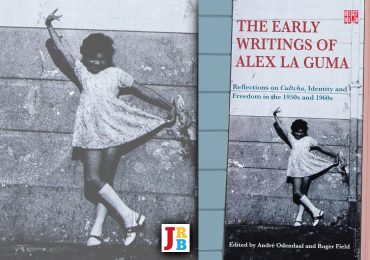Almost every city has been built more than once. Each phase complete with its own architecture and infrastructure and, for a time, the conviction that the evolution finally produced a defining epoch—until the next build begins, disputing that, and carving an ostensibly new distinctiveness. The well-defined development genealogy of city building perhaps originates in mobility, tracing our lineage from horse carriers, to bicycles, to automobiles, to aeroplanes, and now to self-driving cars. The city of Johannesburg has not been spared from these developments. Thought to have been built a total of four times, the city’s cartography tells a labyrinth of histories: the discovery of gold; the Natives Land Act of 19 June 1913; the first general elections in 1994; the multinational metropolis of today.
Johannesburg continues to be rebuilt, with places like Maboneng and the Keyes Art Mile etching a new city from the template of the old. The rebuilding is not always all–encompassing, however—in fact, it hardly ever is. Only after the few have built it do the rest of the city dwellers find a connection with it, redrawing the predetermined map—where a two-lane road was planned the city hawkers have erected makeshift fruit and vegetable stands; where a throughway had been plotted, the residents have closed off the boundary, created a gated community.
In his book Maximum City: Bombay Lost and Found, Suketu Mehta describes a double explosion, in 1944, at the harbour in Bombay, the first shaking the windows of nearby buildings, the second shattering them. About two hundred and ninety-eight people died immediately. In the ensuing chaos, the sky catching fire, the smoke swallowing the city, it began to rain. Bombay had seen a tragedy and almost immediately was making attempts to recover from it.
At any given time, Johannesburg is caught between two moments. These moments are strung on the opposite ends of a pendulum; it is exactly how cities are made. In one part of the city, someone is experiencing excruciating pain, while in another, someone is experiencing their greatest joy. These shifts are not humanly engineered; some other hand, out of view, is doing that.
There are also the deliberate shifts of a city. For the past few years, Maboneng has been at the centre of a shift, geographically and physically, shifting Johannesburg towards a new direction, even slicing it in half. Except maybe not. Even in Maboneng, in which gentrification has been aggressive, sparing no building or street, the city continues to insist on its former identity. On a Sunday, the inner-city dwellers who’ve walked on Fox Street to and from their churches for years still walk there, now moving in between the laid-out tables and chairs of restaurants, filled with visitors.
Areas in cities also have the tendency to alter their identity. Sometimes they change rhythm altogether and learn new ways of dancing. Think of cosmopolitan Hillbrow in the nineteen-seventies, bucking against its apartheid-designated ‘whites only’ identity, to now, in ruins, a different kind of history emerging from it, destroying another. Think of the slow re-emergence of Brixton. The old houses, with large backyards, now being joined by coffee shops and architecturally-designed abodes.
But every city is a palimpsest. All of its buildings, generations of engineers and architects apart, cross paths, with engaging and disengaging gestures. An Art Nouveau building might peek above a Postmodern building. A new coffee shop might pop up downtown where an old corner store once stood. Histories proceeding in different timeframes yet at the same time, still. Some parts of the city never merge their old selves with the new. Instead, over time, they drift apart, and cracks between the differences become visible, an exhibit of disagreements.
In an article published on the Guardian, Njogu Morgan, a postdoctoral research fellow in the history workshop at Wits University, writes about how apartheid killed cycling in Johannesburg. Morgan quotes a newspaper article from 1903:
‘There are few cities in South Africa or in any other part of the world where a large[r] number of cyclists are to be found as in Johannesburg. Nearly every third inhabitant rides a bicycle, and it may be said of the Johannesburg child that he learns to cycle before he can walk.’
Today, the city forces cyclists to squeeze in between motorists, taxis and buses, risking fractures, or death.
Cities are often unable to cope with their rapidly increasing numbers of people and automobiles. Pedestrians and street traders are always squeezed onto the pavement, negotiating whatever small space is left, taking turns making use of it, fighting over it.
The history of Johannesburg lies outside of the CBD, too. Peeking beyond the highways are the remains of mine dumps, the earliest record of how the city was founded in 1886, how it built its wealth, how it became a migrant city. Now, on those very mine dumps, communities have been erected, homes standing where mining once happened. Another palimpsest. Communities enjoying city life on what was essentially a place of torment for the many black labourers who worked there.
In all of these varying vignettes, an image of Johannesburg begins to form, to make sense. In the coming issues of The JRB, we will explore the city of Johannesburg, narrating its story, writing a link between its history and its literature. For a large city like this has its obvious and hidden histories, forming the skeleton of what this city is today, what it will be in the future. Strap in, it is going to be a wild ride.
- Guest City Editor Lidudumalingani is a writer, filmmaker and photographer, and winner of the 2016 Caine Prize. Follow him on Instagram and Twitter.






One thought on “[City Editor] A city caught between two moments—Lidudumalingani considers Johannesburg’s obvious and hidden histories”